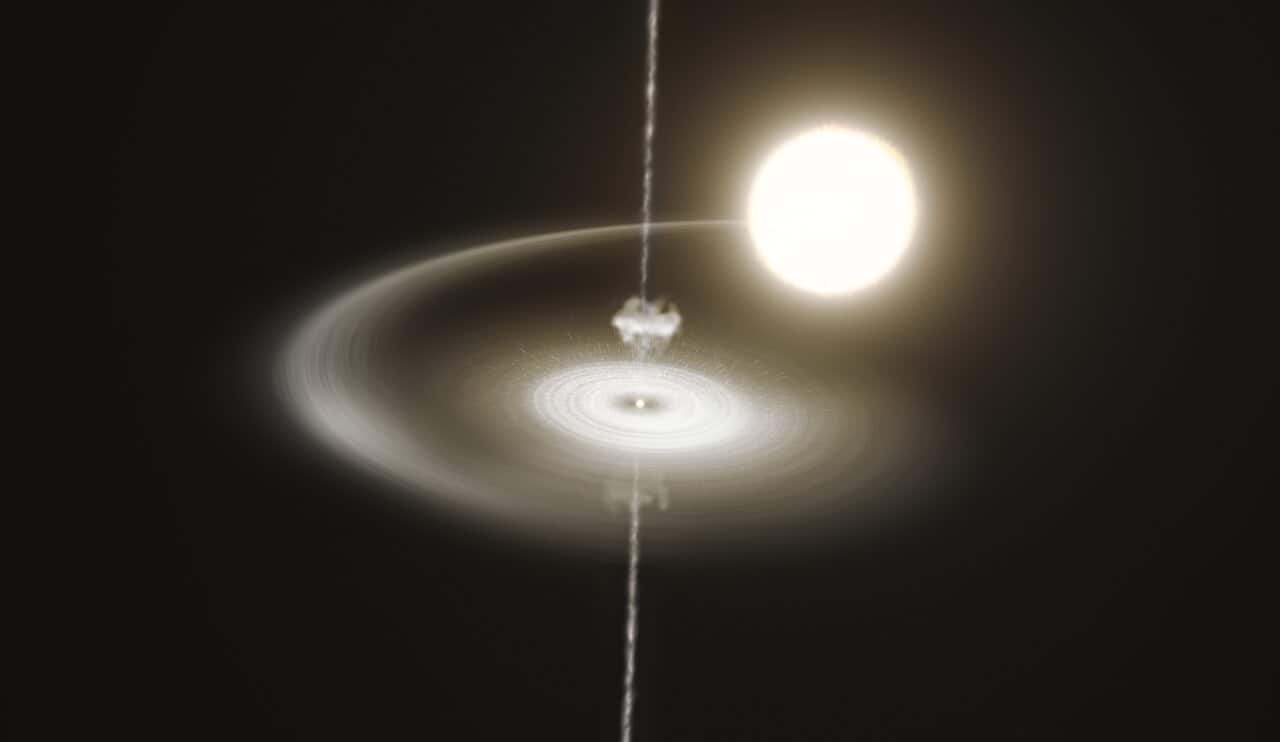
A consortium of astronomers has shed light on the mysterious behavior of one particular pulsar — a rapidly spinning remnant of a star — using a dozen telescopes on Earth and in space. There has long been a mystery surrounding this strange cosmic entity, which alternates between two different states of brightness.
Astronomers have now found that sudden matter ejections from the pulsar over very short spans are responsible for the peculiar switches.
“We have witnessed extraordinary cosmic events where enormous amounts of matter, similar to cosmic cannonballs, are launched into space within a very brief time span of tens of seconds from a small, dense celestial object rotating at incredibly high speeds,” says Maria Cristina Baglio, researcher at New York University Abu Dhabi, affiliated with the Italian National Institute for Astrophysics (INAF), and the lead author of the paper published in Astronomy & Astrophysics.
Pulsars, distinguished by their rapid rotation and magnetic properties, emit concentrated beams of electromagnetic radiation. When these beams cross our line of sight, Earth-based observatories can detect them because they travel through the universe in a manner akin to a lighthouse’s sweeping motion. As a result, pulsars appear to pulse in luminosity from our vantage point on Earth.
This investigation focuses on PSR J1023+0038, or J1023 for short, a peculiar type of pulsar with eccentric behavior. J1023, located approximately 4,500 light-years away in the constellation Sextans, orbits a close companion star. Over the past decade, the pulsar has extracted matter from its neighbor, forming an accretion disc that is succumbing to the pulsar’s gravitational pull.
The pulsars’ distinctive sweeping beam gradually disappeared as this accumulation continued, and in its place, a steady alternation between high and low brightness modes took its place. The pulsar emits intense X-rays, ultraviolet, and visible light in its high-brightness mode. In low mode, however, its luminosity decreases at these frequencies while emitting more radio waves. This rhythmic switching between modes, which typically lasts just seconds or minutes, has baffled astronomers for years.
Francesco Coti Zelati, a researcher at the Institute of Space Sciences in Barcelona, Spain, and co-lead author of the paper, outlined the extensive observing campaign leading to these discoveries. ESO’s Very Large Telescope (VLT) and New Technology Telescope (NTT) as well as the Atacama Large Millimeter/submillimeter Array (ALMA) and nine other telescopes were utilized for this project. Throughout two nights in June 2021, the team recorded more than 280 transitions between the system’s high and low modes.
“Our unprecedented observing campaign to understand this pulsar’s behavior involved a dozen cutting-edge ground-based and space-borne telescopes,” Zelati said. “We have discovered that the mode switching stems from an intricate interplay between the pulsar wind, a flow of high-energy particles blowing away from the pulsar, and matter flowing towards the pulsar.”
The research concluded that the mode switches result from a complex interaction between the pulsar’s high-energy particle emissions, known as the pulsar wind, and the incoming matter. When the low mode is activated, matter approaching the pulsar is ejected in a jet perpendicular to the accretion disc. This material accumulates near the pulsar over time and interacts with the pulsar’s wind, resulting in heating. Subsequently, the system enters high mode, emitting vibrant X-rays, ultraviolet, and visible light. The pulsar eventually ejects chunks of this heated material via the jet, depleting the hot matter on the disc and switching the system back to its low mode.
Even though the discovery has shed light on the mystery surrounding J1023’s behavior, many aspects remain to be investigated. The Chilean construction of ESO’s upcoming Extremely Large Telescope (ELT) will provide an unprecedented vantage point for deciphering J1023’s switching mechanisms. ELT will allow astronomers to gain crucial insights into how mode-switching behavior affects the abundance, distribution, dynamics, and energies of the inflowing matter.









